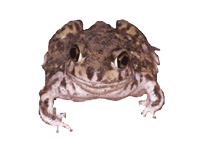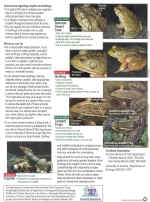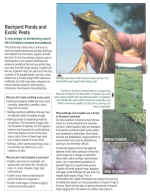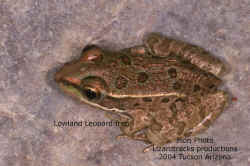Welcome to the home of TUCSON RANA* -
A website devoted to the gathering and posting of information relating to Arizona's native species.
The Tucson Basin, Northern Sonoran Desert and rana species in particular.
To try and help promote awareness and understanding for all about the importance in saving native fauna and environment. Amphibians and reptiles are biological barometers of the ecosystem.
*Restoring Arizona's Native Amphibia
Site Menu:
- The Good (and one bad)-Images and Identification frog and toad song table view
- The Bad
- The Ugly (aftermath)
- Frogs for kids
- Frogs for Mom Dad and Teachers projects & activities
- Latest news
- Field Trips Page
- Submitted local photos
- Toad and Snake avoidance training for fido - for those that want to make sure both your pup and the endangered Sonoran Desert Toad can coexist on the same property.
I've been getting more questions about native plants so some links have been added that are plant specific
- Native Plant & bad plants NEW
- Safe Harbor
- Frog watch
- The Australia hop
- Just rana
- Reports/articles
- The fish
- Mosquitoes concerns
- Organizations
- Arizona Invasive Species list
Free counters provided by Vendio.
| Current time in Tucson |
Do you have unknown tadpoles or amphibians in your yard or water feature? Please check out The Good to help identify your visitors. If you have leopard frog or Sonoran River Toad you want to encourage them to stay. They are both very endangered and need our help. Especially from the introduced American Bullfrog which is one of the contributors to their possible extinction if nothing is done.
You may also send images or questions to Tucsonrana. We are always looking for images or information about any amphibian specifically or reptile you may come across. Please include location.
If you do have Sonoran Toads, which do have a toxic secretion, and you own dog you will have to be careful if you want to keep the species in your yard. If you do want to help bring back the species you will need to train your pup to leave the Toads alone. Similar to snake avoidance training.
>The Humane Society of Tucson offers classes <
| :
Fatal frog fungal disease figured out - Electrolyte imbalance stops amphibians' hearts. Courtesy Nature News CDC site for those that want to really get a lot more: ******* Images - amphibian chytridiomycosis - yahoo Science 23 October 2009:
Full text at sciencemag.org
Help fight Amphibian Chytrid (Chytridiomycosis) Fungus one of the main threats to many amphibians!
Over one-third of the world's amphibian species are considered threatened or endangered. For decades, scientists have studied the disappearance of amphibians and have even discovered some of the possible causes including global climate change, habitat loss and pollution. Recently, an emerging infectious disease known as the Amphibian Chytrid Fungus has been shown to wipe out massive numbers of amphibians from pristine natural locations in many places around the world. This disease is currently unstoppable in the wild, but treatable in captivity Learn more at the following links: Learn how to identify and if found please notify Tucsonrana or Dr Phil Rosen at University of Arizona immediately!! Think Globally Act Locally Field Trips Page! Idea to show submitted images of frogs or toads in their habitats. Any habitat, any region, any country. Frog and Toad cams included. Using a global mapping service you will be able to go to the exact coordinates for each set of images when GPS data is provided. Otherwise you will go to general area. Would like to see this as an interactive page. If anyone has any ideas, please email. lowland@tucsonrana.com Requested images and information:
Until then the Field Trips Page will be the scrap book for pictures people have sent in. Thank you. JUNE 04 2007 DEPARTMENT OF THE INTERIOR Fish and Wildlife Service - Endangered and Threatened Wildlife and Plants; AGENCY: U.S. Fish and Wildlife Service, Interior. ACTION: Notice of availability; final recovery plan for Chiricahua leopard frog. ----------------------------------------------------------------------- SUMMARY: We, the U.S. Fish and Wildlife Service (Service) announce the availability of a final recovery plan for the Chiricahua leopard frog (Rana chiricahuensis). The species occurs in central and southeastern Arizona, west-central and southwestern New Mexico, and the sky islands and Sierra Madre Occidental of northeaster Sonora and northwestern Chihuahua, Mexico. The Chiricahua Leopard Frog Recovery Plan presents information on the species and its habitat, including delisting criteria and recovery actions to conserve the species Click to see full text - [Federal Register: June 4, 2007 (Volume 72, Number 106)] For those that did not receive a copy of the hand-out from Kathryn Mauz's Presentation at the August Meeting of The Tucson Watergardeners Club about the history of aquatic and riparian plants found in the Tucson Basin- Here it is: you will need Adobe Acrobat Tucson-historic-wetland-species_watergardeners082406.pdf NEW BOOK: "Amphibians, Reptiles, and their habitats at Sabino Canyon"
************************************************ Notice
of Availability of the Draft Recovery Plan for the Click below to see the bad or below to see the ugly (results) courtesy of Pima County's Sonoran Desert Conservation Plan Please be responsible - Do Not Release unwanted plants or animals into the wild - If you have aquatic plants or animals you have to get rid of please contact the webmaster of this website or a member of The Tucson Watergardeners
Click on these guys- to see the natives of Tucson Watch for news on:
Congratulations to Laguna Elementary School staff and especially students! They are Grant recipients that with the help of many in the community have a new educational, relaxation pond. Click here to see past programs check out the pages below:
Study has been completed- Thank you all! Do you want to do something to help declining amphibians?See a list of the wanted with images and sounds:the mapping of Tucson's frogs and toads is being compiled Results of a three year study. Tucson's Lowland leopard frogs are coming back! Study shows that our Lowland leopard frog are making a comeback - thank you to those involved. TucsonRana will continue to compile data after this this study. Think globally and act locally.
Tucsonrana will continue to work with U of A and national researchers
in gathering information on frog and toad populations in the city of Tucson and surrounding areas. We need you to
listen for frog and toad choruses in the vicinity of your home. If
you can document any sounds and estimate numbers please email with
any information you can gather, Recordings with images if possible.
You can listen to voices on the
URGENT: Read the post from Phil Rosen- See a list of the wanted with images and sounds: (A page in progress, looking for images and recordings from anyone in the Tucson area. Please send to; lowland@tucsonrana.com Print or download- Category and species sheet- .doc Print or download- Tucson Area Toad and Frog Larval Period Data -.doc Print or download- DATA SHEET DL form-.doc
Rillito River/Dodge to Ina Route Reports, je aug 09 2004 The Monsoon is not being kind to us this year. Except for the southeast and the north side of the Catalina's bringing water to the Pantano and Canada del Oro we are very dry. I haven't seen the Rillito at Dodge or Campbell running side to side yet. We still have a some time for central and west to get some wet. This is also a good time to plan out sites that you would want to go for the survey. Aug 2005 Yet another disappointing year for our wet season. The extended drought conditions are starting to been seen with more clarity now. Trees near the rivers are really starting to show stress. Even the cacti and "drought tolerant" plants are taking a beating. I heard very little activity on the normally noisy route. Let's hope for a better winter/spring rainfall. Reports from Mountain and Roger March 2006 Well that didn't help much. 2 in if we were lucky in the Roger/Mountain area for the winter. Hearing of more incidents of WILDLIFE coming into ponds. I would like to hear from any or all of you that have had or are having close encounters with said Wildlife. Had a raccoon attack in my pond this year, had to get over 5 ft walls to get in. Cats get in so I know there is no problem for one of the midnight bandits. Heard from CH that they had one drinking out of their dogs water dish. Saw him after the backyard motion light came on. So please email with creature, date, time, and location. Would be interesting to see if there are any patterns here. September 2008 UofA extension farm and River Road updates With the road changes to River Road and addition of the Alvernon Way bridge we have lost a lot of native wildlife habitat. Who knows what these will mean. The area around the bridge were usually a high count area for couchi noted during the field study. What was found during the 2008 monsoon was that the Great Plains Toad were much more prevalent. If this is due to changes in habitat or just a natural cycle will have to be studied and documented. Couchi seemed to be less prevalent While Great Plains more this season over all. My thoughts are that it is part of a natural cycle. Let's see what happens during the 09 monsoon. Safe Harbor Agreements Arizona
Safe Harbor Agreement for Topminnow and Pupfish can be seen at: (you will need adobe acrobat to view it online) http://www.setonresourcecenter.com/Register/2004/Mar/25/15362A.pdf OR- or contact:
Have fun! Listen to me - 1 Listen to me -2 Keep watching and listening
|






